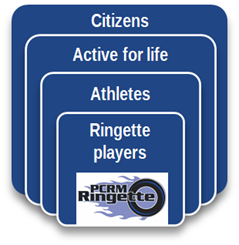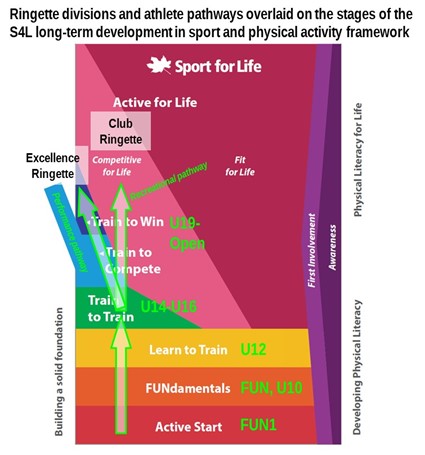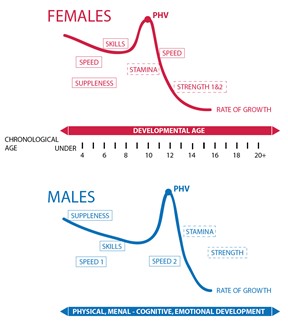Long-term development in sport and physical activity: what members should know
A primary goal of sport is to assist citizens in achieving their potential for healthy and productive lives. This goal is encoded in the Sport Canada policy to promote
physical literacy, which is the “
the motivation, confidence, physical competence, knowledge, and understanding to value and take responsibility for engagement in physical activities for life” [Canada’s Physical Literacy Consensus Statement, 2015].
Physically literate individuals are more likely to choose to be physically active for life, which is important because a physically active lifestyle promotes optimal health and wellbeing.
Furthermore, individuals who are more physically literate also maximize their chances of fully exploiting their athletic potential because they will have had more opportunities to discover sports at which they excel and they are more resilient to injury.
PCRMRA therefore prioritizes developing its members as strong and contributing citizens who are active for life, followed by developing them as athletes, and finally as ringette players

Concepts of athlete development
Athlete development is defined here as the structured series of activities, supports, and milestones that enables an individual to achieve their athletic and personal potential. There are a few concepts relating to athlete development that PCRMRA members should know.
Athlete development is a long-term process
Athletic prowess takes years to develop and requires talent, accumulated hours of practice, biological maturity, and a strong support system. One without the others will limit the athlete’s potential. The long-term nature of athlete development is further emphasized by ringette being classified as a
late specialization sport, in which top-level performance is achieved by those in their late 20s and early 30s. Athlete development is a marathon and not a sprint, and players and parents should keep this concept firmly in mind when making decisions about sport participation, especially in the early years.
Chronological vs. biological maturation
Youth sports commonly classify individuals based on their
chronological age. Indeed, ringette does so with its divisions, e.g., U10, U12, etc. However, individuals mature biologically at different rates, such that an individual who has more talent but who matures more slowly may perform less well at a sport compared to someone who has less talent but who is maturing more quickly.
It is therefore unreasonable to judge a player’s ultimate potential in a sport based on their abilities as a child prior to their growth spurt, and tiering children too early can detrimentally impact the pool of athletes in the higher age divisions.
Practical implications:
- Ringette no longer tiers teams into “A” and “B” divisions based on player tryouts for U12 and lower divisions
- Assess player biological ages. One common measure of biological age is the age corresponding to “peak height velocity”, which is the age at which a child is growing their fastest.
- Ringette still classifies players primarily by chronological age (e.g., U12, U14, etc.) but will consider a child’s biological age in terms of assigning them to a division. Coaches and parents should advocate for players to play up or down a division if they are maturing significantly faster or slower than an average child.
- Parents should avoid prematurely specializing their children in a single sport to enhance their chances to become “elite” athletes. Athletes should be directed into performance pathways at the correct stage of biological maturity (discussed in detail below). There is little to gain from trying to hasten a child’s pursuit of performance pathways.
Sensitive periods of trainability
Some propose that as individuals mature, certain physical qualities are enhanced more easily at certain stages than others. Training programs should therefore be individualized according to the biological stage of maturation. Sport For Life, the non-profit agency whose mandate is to improve the quality of sport in Canada, has defined a seven-stage “long-term athlete development model” (LTAD), which is now known as the
long-term development in sport and physical activity framework (see Figure below). One feature of the framework is to promote physical literacy by emphasizing the acquisition of fundamental movement skills and fundamental sport skills in young children (Active Start and FUNdamentals stages), who learn motor skills more efficiently than older individuals.
Furthermore, athletic abilities such as suppleness/flexibility, speed, strength, and stamina/endurance are thought to be best developed at specific biological ages. This concept is controversial and not universally agreed upon,
and it is important to know that athletic abilities are trainable throughout the lifespan. It is possible, however, that gains may be made more efficiently at certain times than others.
 |
 |
| The Sport For Life stages of long-term development in sport and physical activity, overlaid with the ringette divisions and athlete pathways. Individuals are classified into the stages based on their biological age, so the overlay of divisions corresponds to the average individual. At the Train to Train and beyond stages, athletes have the opportunity to pursue either recreational or performance pathways. [Figure adapted from S4L LTD sport & physical activity 3.0, 2019]. |
Sensitive periods of trainability for five athletic abilities (suppleness/flexibility, speed, strength, motor skills, stamina/endurance) [Ringette Canada LTPD model, 2009]. PHV is “peak height velocity”, which is the age at which a child is growing their fastest. |
Practical implications:
- Parents of children in the Active Start and FUNdamentals stages can promote physical literacy by
- Enrolling children in gymnastics, swimming, running-based sports (e.g., soccer), and an ice sport such as ringette.
- Teaching your children to ride a bicycle.
- Playing catch with your kids (throwing and catching are two of the land-based fundamental movement skills).
- As children mature through the FUNdamentals stage, parents can promote physical literacy by
- Encouraging their children to engage in diverse physical activities and sports. “Sampling” sports and activities fosters a child’s physical literacy because it helps them to learn a broad “movement vocabulary”. Help your child sample diverse activities by
- enrolling them in several different sports over the course of a year,
- enrolling them in multisport day camps offered through community centres,
- encouraging them to participate in school-based physical education and sports,
- encouraging them to participate in recreational physical activities, especially outdoor activities like hiking, bicycling, swimming, and skiing.
- Prior to the Train to Train stage, parents should resist the (often very strong) temptation to specialize their children in a sport prior to their growth spurt. In general, choose variety. Avoid year-round participation in a single sport, or even “seasons beyond the regular season” (e.g., spring ice sports).
- Starting with the Train to Train stage, athletes will generally need to start specializing to achieve their potential. Members should understand the eventual profound commitment required for achieving athletic excellence, which includes daily year-round training both on- and off the ice, dedication to recovery through nutrition and sleep, and a strong support system that defrays the costs of involvement and helps the player balance sport participation with other important aspects of life such as academics. The degree of specialization and the overall training load should be increased progressively over the course of several years. More specific guidelines for each stage of the long-term development framework are provided in the Ringette Canada Long-Term Player Development document.
- Athletes biological ages should be monitored in order to best identify their stage of athlete development.
Athlete pathways
In British Columbia, ringette players follow a common pathway until the end of U12 (the Learn to Train stage). In the U14 division, performance-focused and recreational pathways become available in the form of Zone Representative teams and community-based Club teams, respectively, which continue through to U19. At the U16 level and beyond, qualifying athletes can pursue
Excellence Ringette, which is Ringette BC’s high-performance pathway that seeks to prepare athletes and coaches for national- and international-level competition, such as the Canadian Ringette Championships, Canada Winter Games, National Ringette League, and World Ringette Championships.
Transitioning to Competitive for Life and Active for Life
Only a small percentage of ringette players will enter the high-performance Train to Compete and Train to Win stages (Excellence Ringette). Beyond the Train to Train stage, athletes who continue with ringette will transition to the Competitive for Life and Active for Life stages. It is important that players have well developed physical literacies at this point, so that they value physical activity and are able to confidently and competently select physical activities that best promote their health, wellbeing, quality of life, and ringette performance goals.
Talent identification in Canadian high-performance sport
RBC Training Ground is a talent identification program for Canadian Olympic and Paralympic Sport. Ringette athletes may have talent for other sports that are in the Olympic or Paralympic programs, and RBC Training Ground runs events in which interested athletes perform a series of tests to determine sports in which they might be best suited.
While Covid-19 has postponed future events, check this website for possible future events once Covid restrictions are further loosened:
https://www.csipacific.ca/programs/podium-search/rbc-training-ground/
Practical implications:
- Starting in the Learn to Train stage, players should be educated in the concepts of physical literacy, the 24-hr Canadian Movement Guidelines, and training for physical fitness (see the Off-ice Training tab). By the end of the Train to Train stage, athletes should be able to make informed choices about their physical activities and for training for ringette.
How is athlete development fostered within the PCRMRA?
All members have roles to play in developing PCRMRA athletes. Some of the points below represent ideals that we are striving to achieve.
- Participation and support for all members:
- Enhance and sustain an inclusive, supportive, and positive learning environment for all PCRMRA members. A critical mass of athletes is necessary for the success of our programs.
- Work to sustain participation in the sport especially for those in the Train to Train stage.
- Maintain strong Open and Masters programs to promote lifelong participation in the sport.
- Support high-performance players by assisting them to have a daily training environment and integrated support (strength and conditioning, nutrition, mental performance, health).
- Stages prior to Train to Train (~U14 for most players): Promote multisport development and resist the strong temptation to specialize athletes in ringette. Encourage players to play “complementary” sports that emphasize fundamental movement skills that are not practiced in ringette.
- Evaluate players holistically: in addition to sport-specific skills that are currently evaluated through the Ringette Canada, player evaluations ought to include the following:
- Assessment of biological age
- Player physical literacies
- Ringette BC LTAD skills matrix
- These aspects should be monitored yearly and feedback provided to players, parents, and coaches.
- Ensure teams at each division are providing developmentally appropriate activities that align with long-term athlete development concepts and ringette-specific sport skills (e.g., the Ringette BC LTAD skills matrix). Coach season plans should ensure that all skills are covered.
- Encourage off-ice activities to promote daily physical activity and physical fitness in players.
Further reading
S4L Long-term development in sport and physical activity 3.0:
https://sportforlife.ca/portfolio-view/long-term-development-in-sport-and-physical-activity-3-0/
Ringette Canada Long-term player development model (from 2009, is likely to be replaced soon):
http://ltrd.ringette.ca/wp-content/uploads/2015/09/Ringette_mag_EN_WEBversion.pdf
Ringette Canada Athlete Development Matrix 2020:
http://ltrd.ringette.ca/athlete/athlete-development-matrix/